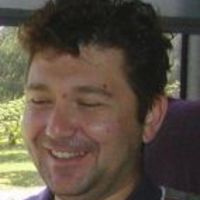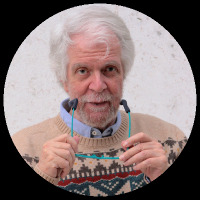Papers by Adayabalam Balajee
Mutation Research, Dec 1, 2018
Chromosomes are the vehicles of genes, which are the functional units of a cell's nucleus. In hum... more Chromosomes are the vehicles of genes, which are the functional units of a cell's nucleus. In humans, there are more than 20,000 genes that are distributed among 46 chromosomes in somatic cells. The study of chromosome structure and function is known as cytogenetics which is

Nature Communications, Dec 2, 2020
The three-dimensional structure of chromosomes plays an important role in gene expression regulat... more The three-dimensional structure of chromosomes plays an important role in gene expression regulation and also influences the repair of radiation-induced DNA damage. Genomic aberrations that disrupt chromosome spatial domains can lead to diseases including cancer, but how the 3D genome structure responds to DNA damage is poorly understood. Here, we investigate the impact of DNA damage response and repair on 3D genome folding using Hi-C experiments on wild type cells and ataxia telangiectasia mutated (ATM) patient cells. We irradiate fibroblasts, lymphoblasts, and ATM-deficient fibroblasts with 5 Gy X-rays and perform Hi-C at 30 minutes, 24 hours, or 5 days after irradiation. We observe that 3D genome changes after irradiation are cell type-specific, with lymphoblastoid cells generally showing more contact changes than irradiated fibroblasts. However, all tested repairproficient cell types exhibit an increased segregation of topologically associating domains (TADs). This TAD boundary strengthening after irradiation is not observed in ATM deficient fibroblasts and may indicate the presence of a mechanism to protect 3D genome structure integrity during DNA damage repair.

The RABiT-II DCA in the Rhesus Macaque Model
Radiation Research, Oct 6, 2020
An automated platform for cytogenetic biodosimetry, the “Rapid Automated Biodosimetry Tool II (RA... more An automated platform for cytogenetic biodosimetry, the “Rapid Automated Biodosimetry Tool II (RABiT-II),” adapts the dicentric chromosome assay (DCA) for high-throughput mass-screening of the population after a large-scale radiological event. To validate this test, the U.S. Federal Drug Administration (FDA) recommends demonstrating that the high-throughput biodosimetric assay in question correctly reports the dose in an in vivo model. Here we describe the use of rhesus macaques (Macaca mulatta) to augment human studies and validate the accuracy of the high-throughput version of the DCA. To perform analysis, we developed the 17/22-mer peptide nucleic acid (PNA) probes that bind to the rhesus macaque’s centromeres. To our knowledge, these are the first custom PNA probes with high specificity that can be used for chromosome analysis in M. mulatta. The accuracy of fully-automated chromosome analysis was improved by optimizing a low-temperature telomere PNA FISH staining in multiwell plates and adding the telomere detection feature to our custom chromosome detection software, FluorQuantDic V4. The dicentric frequencies estimated from in vitro irradiated rhesus macaque samples were compared to human blood samples of individuals subjected to the same ex vivo irradiation conditions. The results of the RABiT-II DCA analysis suggest that, in the lymphocyte system, the dose responses to gamma radiation in the rhesus macaques were similar to those in humans, with small but statistically significant differences between these two model systems.
Sensitivity of Werner’s Syndrome Cells to DNA Damaging Agents: Insights into the Biological Functions of the Werner Protein
Mutation Research, Dec 1, 2018
Back in India, Nat set up his own research group to examine the localization of break points on V... more Back in India, Nat set up his own research group to examine the localization of break points on Vicia faba chromosomes after treatment with various alkylating agents. This seminal finding eventually led to the development of chromosome Q-banding that relied on DNA base composition. After working for a while in India, Nat's strong desire to excel in science drove him to Stockholm, Sweden where he obtained his second Ph.D. degree in 1966 in Radiation Biology under Professor Lars Ehrenberg. After working on plant cells for almost two decades, Nat decided to study animal cells because funding for basic research on

A comparative validation of biodosimetry and physical dosimetry techniques for possible triage applications in emergency dosimetry
Journal of Radiological Protection, Mar 22, 2022
Large-scale radiological accidents or nuclear terrorist incidents involving radiological or nucle... more Large-scale radiological accidents or nuclear terrorist incidents involving radiological or nuclear materials can potentially expose thousands, or hundreds of thousands, of people to unknown radiation doses, requiring prompt dose reconstruction for appropriate triage. Two types of dosimetry methods namely, biodosimetry and physical dosimetry are currently utilized for estimating absorbed radiation dose in humans. Both methods have been tested separately in several inter-laboratory comparison exercises, but a direct comparison of physical dosimetry with biological dosimetry has not been performed to evaluate their dose prediction accuracies. The current work describes the results of the direct comparison of absorbed doses estimated by physical (smartphone components) and biodosimetry (dicentric chromosome assay (DCA) performed in human peripheral blood lymphocytes) methods. For comparison, human peripheral blood samples (biodosimetry) and different components of smartphones, namely surface mount resistors (SMRs), inductors and protective glasses (physical dosimetry) were exposed to different doses of photons (0–4.4 Gy; values refer to dose to blood after correction) and the absorbed radiation doses were reconstructed by biodosimetry (DCA) and physical dosimetry (optically stimulated luminescence (OSL)) methods. Additionally, LiF:Mg,Ti (TLD-100) chips and Al2O3:C (Luxel) films were used as reference TL and OSL dosimeters, respectively. The best coincidence between biodosimetry and physical dosimetry was observed for samples of blood and SMRs exposed to γ-rays. Significant differences were observed in the reconstructed doses by the two dosimetry methods for samples exposed to x-ray photons with energy below 100 keV. The discrepancy is probably due to the energy dependence of mass energy-absorption coefficients of the samples extracted from the phones. Our results of comparative validation of the radiation doses reconstructed by luminescence dosimetry from smartphone components with biodosimetry using DCA from human blood suggest the potential use of smartphone components as an effective emergency triage tool for high photon energies.

Radiation Protection Dosimetry, 2016
The RABiT (Rapid Automated Biodosimetry Tool) is a dedicated Robotic platform for the automation ... more The RABiT (Rapid Automated Biodosimetry Tool) is a dedicated Robotic platform for the automation of cytogenetics-based biodosimetry assays. The RABiT was developed to fulfill the critical requirement for triage following a mass radiological or nuclear event. Starting from well-characterized and accepted assays we developed a custom robotic platform to automate them. We present here a brief historical overview of the RABiT program at Columbia University from its inception in 2005 until the RABiT was dismantled at the end of 2015. The main focus of this paper is to demonstrate how the biological assays drove development of the custom robotic systems and in turn new advances in commercial robotic platforms inspired small modifications in the assays to allow replacing customized robotics with 'off the shelf' systems. Currently, a second-generation, RABiT II, system at Columbia University, consisting of a PerkinElmer cell::explorer, was programmed to perform the RABiT assays and is undergoing testing and optimization studies.
Current developments in biodosimetry tools for radiological/nuclear mass casualty incidents
Environmental advances, Oct 1, 2022
The novel tumor suppressor gene Hint1 may play a role in DNA damage responses by modulating the activity of Tip60
Cancer Research, May 1, 2007
Chromosome translocation in a female with a history of fetal loss and chronic progressive multiple sclerosis
Chromosome science, 2017
Mutation Research, 2021
Please cite this article as: Balajee AS, Hadjidekova V, Retrospective cytogenetic analysis of uns... more Please cite this article as: Balajee AS, Hadjidekova V, Retrospective cytogenetic analysis of unstable and stable chromosome aberrations in the victims of radiation accident in Bulgaria,
Mechanism of radiation carcinogenesis: Lessons from telomerase-immortalized human small airway epithelial cells
The Japan Radiation Research Society Annual Meeting Abstracts The 47th Annual Meeting of The Japan Radiation Research Society, 2004

bioRxiv (Cold Spring Harbor Laboratory), Aug 20, 2019
The three-dimensional structure of chromosomes plays an important role in gene expression regulat... more The three-dimensional structure of chromosomes plays an important role in gene expression regulation and also influences the repair of radiation-induced DNA damage. Genomic aberrations that disrupt chromosome spatial domains can lead to diseases including cancer, but how the 3D genome structure responds to DNA damage is poorly understood. Here, we investigate the impact of DNA damage response and repair on 3D genome folding using Hi-C experiments on wild type cells and ataxia telangiectasia mutated (ATM) patient cells. Fibroblasts, lymphoblasts, and ATM-deficient fibroblasts were irradiated with 5 Gy X-rays and Hi-C was performed after 30 minutes, 24 hours, or 5 days after irradiation. 3D genome changes after irradiation were cell type-specific, with lymphoblastoid cells generally showing more contact changes than irradiated fibroblasts. However, all tested repairproficient cell types exhibited an increased segregation of topologically associating domains (TADs). This TAD boundary strengthening after irradiation was not observed in ATM deficient fibroblasts and may indicate the presence of a mechanism to protect 3D genome structure integrity during DNA damage repair.

Data from Human Helicase RECQL4 Drives Cisplatin Resistance in Gastric Cancer by Activating an AKT–YB1–MDR1 Signaling Pathway
Elevation of the DNA-unwinding helicase RECQL4, which participates in various DNA repair pathways... more Elevation of the DNA-unwinding helicase RECQL4, which participates in various DNA repair pathways, has been suggested to contribute to the pathogenicity of various human cancers, including gastric cancer. In this study, we addressed the prognostic and chemotherapeutic significance of RECQL4 in human gastric cancer, which has yet to be determined. We observed significant increases in RECQL4 mRNA or protein in >70% of three independent sets of human gastric cancer specimens examined, relative to normal gastric tissues. Strikingly, high RECQL4 expression in primary tumors correlated well with poor survival and gastric cancer lines with high RECQL4 expression displayed increased resistance to cisplatin treatment. Mechanistic investigations revealed a novel role for RECQL4 in transcriptional regulation of the multidrug resistance gene MDR1, through a physical interaction with the transcription factor YB1. Notably, ectopic expression of RECQL4 in cisplatin-sensitive gastric cancer cells with low endogenous RECQL4 was sufficient to render them resistant to cisplatin, in a manner associated with YB1 elevation and MDR1 activation. Conversely, RECQL4 silencing in cisplatin-resistant gastric cancer cells with high endogenous RECQL4 suppressed YB1 phosphorylation, reduced MDR1 expression, and resensitized cells to cisplatin. In establishing RECQL4 as a critical mediator of cisplatin resistance in gastric cancer cells, our findings provide a therapeutic rationale to target RECQL4 or the downstream AKT–YB1–MDR1 axis to improve gastric cancer treatment. Cancer Res; 76(10); 3057–66. ©2016 AACR.
Data from <i>TGFBI</i> Deficiency Predisposes Mice to Spontaneous Tumor Development
Supplementary Materials and Methods from Human Helicase RECQL4 Drives Cisplatin Resistance in Gastric Cancer by Activating an AKT–YB1–MDR1 Signaling Pathway
1. Construction of Tissue Microarray (TMA). 2. Chemicals. 3. Real-time PCR. 4. Dual-Luciferase as... more 1. Construction of Tissue Microarray (TMA). 2. Chemicals. 3. Real-time PCR. 4. Dual-Luciferase assay for MVP. 5. In vitro pull-down assay. 6. Co-immunoprecipitation. 7. Protein expression and purification. 8. Chromatin immunoprecipitation analysis 9. Electrophoretic mobility shift assays (EMSAs). 10.PCR-SSCP protocol.

Supplementary Figures 1 through 8 and Supplementary Tables 1 through 4 from Human Helicase RECQL4 Drives Cisplatin Resistance in Gastric Cancer by Activating an AKT–YB1–MDR1 Signaling Pathway
1. Supplementary Figure S1. PCR-SSCP analysis of 21 exons of human RecQL4 gene in human gastric c... more 1. Supplementary Figure S1. PCR-SSCP analysis of 21 exons of human RecQL4 gene in human gastric cancer cell lines. 2. Supplementary Figure S2. PCR-SSCP analysis of 21 exons of human RecQL4 gene in human primary gastric tumors and matched gastric tissue controls. 3. Supplementary Figure S3. DNA sequencing result of exons 2-3 of human RecQL4 gene in AGS and HGC-27 cells. 4. Supplementary Figure S4. Coomassie brilliant blue staining images of purified tagged-proteins expressed in E. Coli. 5. Supplementary Figure S5. YB1 domains specifically interacting with RecQL4. 6. Supplementary Figure S6. Level of YB1 and Akt interaction in cytoplasmic(C) and nuclear (N) fractions from MGC-803/Tet-on/Flag-RecQL4 cells with or without RecQL4 induction. 7. Supplementary Figure S7. Effect of YB1 and RecQL4 on MVP promoter activity. 8. Supplementary Figure S8. In vitro direct binding of YB1 and/ RecQL4 proteins to MDR1 promoter region detected by EMSA analysis. 9. Supplementary Table S1. Clinicopathological characteristics of patients with early gastric adenocarcinomas. 10. Supplementary Table S2. Correlation of RecQL4 nuclear and cytoplasmic expression with clinical parameters of gastric cancer patients. 11. Supplementary Table S3. Primer sets of 21 exons of human RecQL4 gene used for PCR-SSCP analysis. 12. Supplementary Table S4. PCR primer sets of drug resistance related genes used for real time RT-PCR analysis.








Uploads
Papers by Adayabalam Balajee